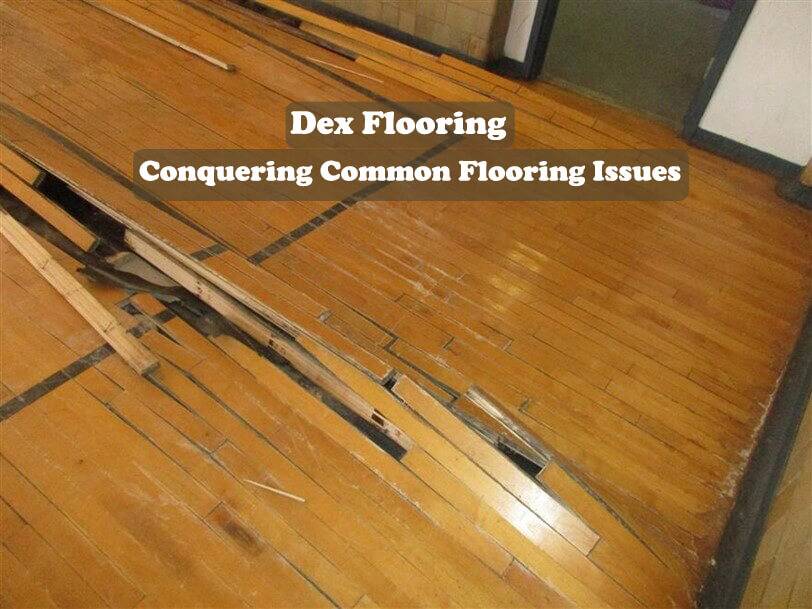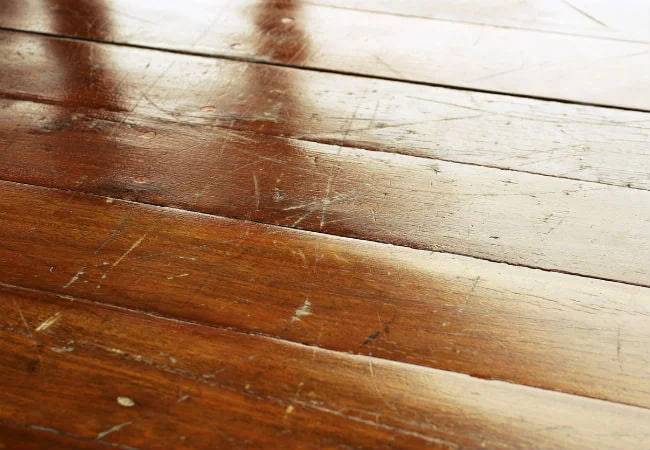Is your flooring showing signs of wear and tear? Scratches, stains, and damage from everyday life can take a toll, especially in high-traffic areas. But fret not! This guide will equip you with the knowledge and solutions to Conquering Common Flooring Issues. From filling in minor imperfections to silencing squeaks, you’ll learn simple techniques and helpful tips to restore your floors to their former glory.
Scratches
Scratches are a common concern for wood floors, especially in high-traffic areas. Furniture, pet claws, and even everyday use can leave behind these unsightly marks. However, don’t despair! Dealing with most scratches is easier than you think.
Minor Scratches:
- Wax sticks and commercial scratch restorers are your go-to solutions for these.
- Apply them gently to the scratch, following the product instructions.
Deeper Gouges:
- Wood filler, tinted to match your floor color, is the answer.
- Use a plastic putty knife to apply and smooth the filler into the gouge.
- Once dry, sand gently with fine-grain sandpaper, followed by cleaning dust.
- Apply a color-matched wood stain for a seamless finish.
Preventing Scratches:
An ounce of prevention is worth a pound of cure! Here are some tips:
- Encourage guests to remove shoes.
- Place rugs in high-traffic areas.
- Buy furniture pads for furniture legs.
- Regularly trim pet claws.
Professional Help:
While most scratches are manageable, extensive damage might require professional intervention. In such cases, consulting a flooring service is the best course of action. Their expertise can save you time, money, and further damage to your beloved wood floors.
Conquering Stains on Wood Floors
Dark water stains can mar the beauty of your wood floors, but don’t panic! Early action makes tackling them relatively simple.
First Steps:
- Non-toxic enzyme cleaner: This natural solution effectively removes pet accidents, ink, and other stains from hardwood floors.
- Gentle approach: Avoid abrasive scrubbing, which can damage the finish. Use a soft brush or mop to lift as much of the stain as possible, extending to surrounding boards.
- Cleaning routine: Vacuum and sweep the cleaned area thoroughly.
For stubborn stains:
- Extra fine sanding (180-240 grit): This requires hand-sanding with the grain of the wood, overlapping onto surrounding boards.
- Advanced cleaning (optional): If sanding doesn’t suffice, consider using a tack cloth or steel wool (with proper safety equipment like a dust mask and eye protection) for a more powerful clean.
Last resort (consult a professional before attempting):
- Hydrogen peroxide bleaching: Soak a cloth in peroxide and apply it to the stain for an hour. If the stain persists, carefully sand the area again and clean with a specialized wood floor cleaner. Remember: This method requires thorough sanding, waxing, and buffing of the entire floor afterward.
Remember: When in doubt, consult a professional who can effectively address the stain without risking further damage to your beloved wood floors.
Cracks
Don’t ignore large cracks in your concrete slab floors! They can signal potential water damage and compromise your home’s structural integrity. Thankfully, addressing them is achievable with the right approach.
While concerning, minor surface cracks usually don’t indicate foundation issues. However, sealing them is crucial to prevent water infiltration and potential future problems.
Here’s how to tackle concrete floor cracks:
- Preparation: Use a chisel to remove any obstructions hindering the repair mix from adhering. Clean the area thoroughly to ensure optimal bonding.
- Patching: Apply a concrete repair mix using a trowel. Popular options include standard epoxy sand mixtures or polymer-modified cement patches.
- Addressing Underlying Causes: If your home rests on clay soil, recurring cracks might be due to seasonal moisture fluctuations. Clay expands when wet and contracts when dry, exerting pressure on the foundation and causing cracks.
Remember: When dealing with extensive cracks or concerns about your foundation, consulting a professional is highly recommended. Their expertise can ensure proper repairs and prevent future issues.
Bridging the Gap: Solutions for Floor-to-Wall Gaps
Gaps between your floor and wall are more than just an eyesore. They can trap dirt, create tripping hazards, and allow drafts.
Understanding the Cause:
The culprit behind many gaps is seasonal humidity fluctuations. Floorboards, especially wood, expand with higher humidity and may naturally close the gaps again when drier.
Taking Action:
- Small gaps (dime-sized): These often close on their own with humidity changes.
- Large gaps (wider than a dime): Consult a flooring specialist for professional assessment and potentially major repairs.
DIY Solutions (for smaller gaps):
- Face-grain wood plug: This matches the color and type of your existing floorboards, creating a seamless and natural repair. Ensure the plug fits snugly.
- Cut flooring strips: If you have leftover flooring material, cut strips to match the gap size. Apply wood glue and gently hammer them into place without damaging surrounding boards.
- Stained rope or jute: This economical option involves staining a piece of rope to match your floor and carefully inserting it into the gap for a disguised seal. Measure precisely for the perfect fit.
Remember: While these DIY solutions address smaller gaps, consult a professional for extensive damage or concerns about your foundation.
Conclusion
Flooring is an essential element of your home, but it can also be susceptible to wear and tear over time. This guide has equipped you with the knowledge and solutions to tackle common flooring problems, from minor scratches and stains to cracks and gaps. Remember, prevention is key, and taking steps like placing rugs in high-traffic areas and regularly cleaning your floors can go a long way in preserving their beauty and longevity. However, when faced with more extensive damage, don’t hesitate to consult a professional for expert advice and repairs.
For top-quality flooring solutions and expert advice, visit Dex Flooring today! We offer a wide variety of flooring options, from classic hardwoods to modern vinyl, and our experienced team can help you find the perfect solution for your needs and budget. Browse our extensive selection online or visit our showroom to experience the Dex Flooring difference!
FAQs
Q: How often should I clean my floors?
A: The frequency of cleaning depends on the type of flooring and the amount of foot traffic it receives. However, it’s generally recommended to sweep or vacuum your floors daily and mop them once a week.
Q: Can I use the same cleaning products for all types of flooring?
A: No, using the wrong cleaning products can damage your floors. Always refer to the manufacturer’s recommendations or consult a professional for advice on the best cleaning products for your specific flooring type.
Q: Should I refinish my scratched wooden floors?
A: Refinishing is a major undertaking and should only be considered for extensive damage or if you want to completely change the look of your floors. For minor scratches, using a wax stick or scratch repairer is usually sufficient.
Q: How can I prevent cracks in my concrete floors?
A: Maintaining a consistent indoor humidity level can help minimize the risk of cracks caused by seasonal fluctuations. Additionally, addressing any leaks or moisture issues promptly can prevent water damage and subsequent cracking.
Q: I’m not comfortable fixing the flooring myself. Who can I contact for professional help?
A: You can find qualified flooring professionals through online directories, referrals from friends and family, or contacting your local hardware store for recommendations.




